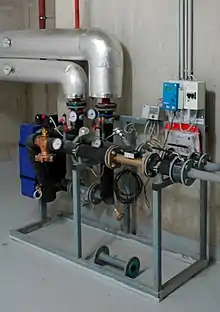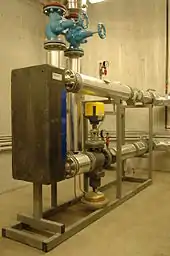District heating substation
A district heating substation is a component in a district heating system that connects the main network to a building's own heating system.[1] [2] [3]

A district heating substation in a residential neighborhood with a thermal capacity of 300 kW. Two components of the heat meter are visible: the metering electronics unit on the right (white/blue box), and the ultrasonic flow meter in the center (bronze tube).

A district heating substation with a thermal capacity of 700 kW. This unit isolates the water circuit of the district heating system from the customer's central heating system.
The station normally has one or more of the following parts:
- Heat exchanger - to split primary and secondary side of the system
- Control valve - to regulate the flow through the heat exchanger
- Differential pressure controller - to balance the network and improve working conditions of control valve
- Strainer - to remove particles that could block heat exchanger or control valve
- Shut off valve - to stop the flow on primary side in case of service or emergency
- Heat meter - to measure energy consumption and allocate costs
- Temperature controller - to control temperature on secondary side by regulating the flow on primary side
- Temperature sensor - to sense flow and return temperatures required for temperature control
In addition, a district heating substation may also include:
- Pump
- Safety valve
- Manometer
- Non-return valve
References
- http://www.ees.energy.lth.se/fileadmin/ees/Publikationer/1997/1012.pdf Janusz Wollerstrand: District Heating Substations
- EUROHEAT & POWER: GUIDELINES FOR DISTRICT HEATING SUBSTATIONS Archived September 10, 2011, at the Wayback Machine, October 2008
- Presentation: GUIDELINES FOR DISTRICT HEATING SUBSTATIONS
This article is issued from Wikipedia. The text is licensed under Creative Commons - Attribution - Sharealike. Additional terms may apply for the media files.
